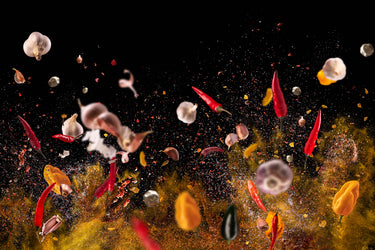How To Make Food Less Spicy

We’ve all been there: gone too hard on the jalapeños or been ham-fisted with the curry paste. Thankfully, all is not lost if you’ve dumped in too much cayenne or poured a tablespoon instead of a teaspoon of hot sauce into your stew. You can neutralize spicy food and more with a few simple strategies.
Why do we like spicy food?
Chilis contain chemical compounds called capsaicinoids (with capsaicin being the most abundant), which are responsible for your brain’s perception of spiciness. Capsaicinoids make the pain receptors on your tongue (and in other mucus membranes in your mouth) react to the spicy food as though it’s physically hot. Though they produce a feeling of heat, they’re not actually burning your mouth. But, this reaction in turn causes the body to produce adrenaline—the chemical that makes your heart race and prepares the body for “fight or flight” responses. Scientists believe that endorphins are also released by the body in response to this process, which could explain why some people seem nearly addicted to eating spicy food.
6 ways to make your food less spicy
Balance the heat with acid
There’s a reason that so many spicy foods from curries to tacos are served with a wedge of lime. Not only does acid brighten the other flavors, it neutralizes capsaicin’s alkaline properties. Stir citrus juice or vinegar or yogurt into foods that are too fiery for your taste. If you don’t want to add one of these foods to the dish, drink an acidic beverage alongside your meal.
Add a dollop of dairy
Capsaicin molecules have a non-polar molecular structure, which means that they can bind with other similar molecules. While it can be tempting to wash spicy food down with a big gulp of water or dilute a spicy stew with water, it’s better to use dairy, since it can bind with capsaicin’s molecular structure. All this means that if you’ve made something too spicy, a glug of milk, a dollop of yogurt, or a handful of grated cheese will neutralize the heat. If you choose an acidic dairy product (like sour cream or yogurt) you’ll get the double benefit of neutralizing the alkaline oil.
Neutralize the spiciness with something sweet
It is possible that consuming sugar alongside capsaicin will reduce the perception of burning in the mouth. The problem is, not every food can tolerate a teaspoon of sugar, or another sweet food. If that’s the case, chase the bites of spicy food with a sweet beverage. Make it sweet, acidic, and dairy-based and you’ve got a winner—think of the mango lassi popular in Indian cuisine.
Change the ratios
Dilute spicy liquids or bulk up on other ingredients to help make spicy foods less intense. If you’re making a curry, add more coconut milk or more of the protein you’re using. For a chili, add more ground beef, vegetables, and/or beans. The goal is to make it so that the spice--[-= already cooked into the dish becomes smaller in proportion to the other ingredients.
Serve spicy food with something mild
Not only does spooning a batch of fiery food over rice or potatoes change the ratio of the dish, the food acts as a physical barrier to the receptors on your tongue, making it less likely they’ll come in contact with the capsaicin.
Add garnishes that counteract the heat
Finish a serving of your super spicy dish off with a variety of toppings that will tame the heat. For example, a bowl of overly fiery chili could benefit avocado, cheese, sour cream, radishes, and cilantro. Or, spoon raita over a too-hot dal and serve with lime wedges and cilantro.
There are many ways to neutralize spicy food if you’ve gone too far with the chilis. If you’re sensitive to heat, start with just a fraction of what the recipe calls for. It can also help to cut the white seeds out of chili peppers before proceeding with a recipe. A good rule of thumb is: You can always dial up the fire, but it’s much harder to pull it back.
Sources:
Helmenstine, Anne. “How to Make Hot Peppers Stop Burning.” Science Notes and Projects, 14 Aug. 2015, sciencenotes.org/how-to-make-hot-peppers-stop-burning/.
“Why Do We like Spicy Food?” BBC Bitesize, www.bbc.co.uk/bitesize/articles/zvsgr2p.





